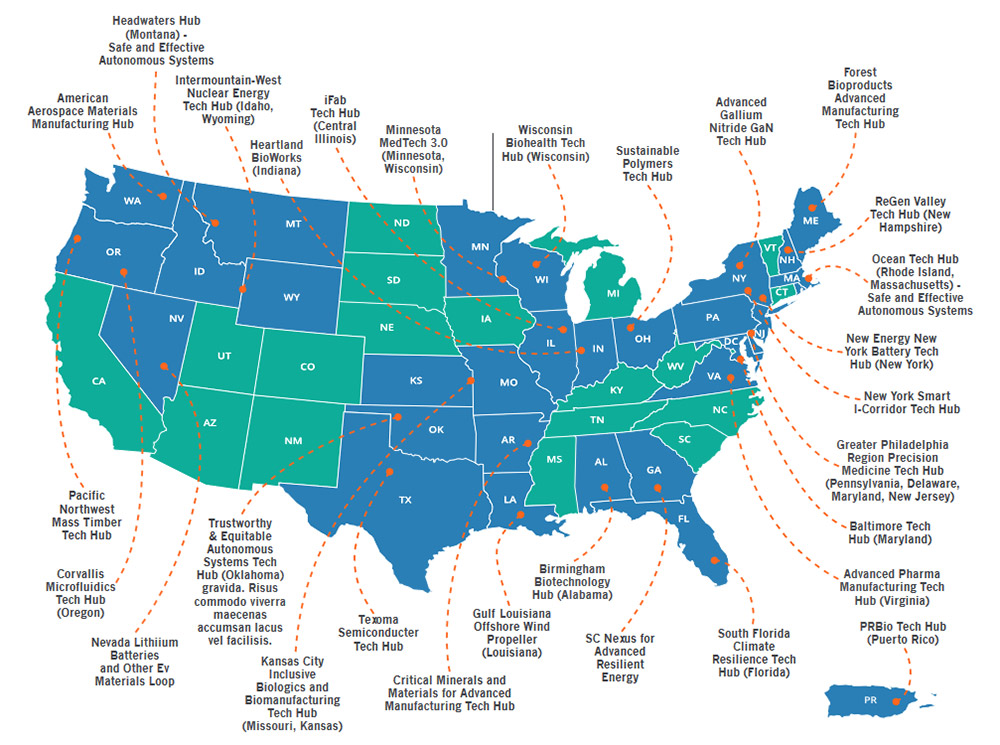The program aims for a significant funding pool of $10 billion, though initially, it has received only $500 million from Congress. This has set the stage for intense competition among the hubs for the first round of grants, which could amount to as much as $75 million each. The limited pool of initial funds means the program will have to make some tough choices among it’s 31 applicants.
"One of the challenges really is the budget,” Eric Smith, the Director of Tech Hubs, told Area Development Magazine. “We are pretty constrained in the number of these hubs that we can select right now."
Despite these constraints, the program's structure is designed to maximize impact by fostering collaboration across academia, government, industry, and the workforce. Nearly 200 private businesses have already joined as consortia members, positioning these hubs as dynamic centers for innovation and economic growth.
$10 billion --- that’s how much funding has been earmarked for the Tech Hubs program, however, only $500 million has yet been appropriated. The hubs focus on a variety of technological areas, each chosen to push forward specific advancements:
- Autonomous Systems: Developing cutting-edge technologies for drones and autonomous vehicles.
- Quantum Computing: Revolutionizing computing power and security capabilities.
- Biomanufacturing: Utilizing biological processes to create sustainable industrial products.
- Precision and Predictive Medicine: Innovating in healthcare to tailor treatments to individual genetic profiles.
- Energy Transition: Accelerating the shift to renewable energy sources.
- Critical Mineral Supply Chain: Strengthening the availability of essential materials for high-tech industries.
- Semiconductor Manufacturing: Boosting domestic production to reduce foreign dependencies.
- Materials Manufacturing: Pioneering in materials science to develop more efficient and durable materials.

“One of the bigger pros of TechHubs is how they foster startups,” said Francesco Renna, Director of Consultation and Senior Labor Economist for Chmura Analytics. " Startups are the engine of innovation but can struggle with higher failure rates in some environments. Luckily, these Tech Hubs nurture startups and provide them with the resources, mentorship, and networking opportunities they need to thrive."
An essential component of the hubs' governance is the POWER framework, which emphasizes Partnerships, Organization, Workflow efficiency, Economic impact, and Resource optimization. This structured approach ensures that hub activities are aligned with broader economic strategies, offering a competitive edge to manufacturing executives looking to innovate or expand. Effective governance within these hubs fosters internal efficiency, enhances external communication, and ensures sustainable resource management.
For manufacturing executives, the strategic decision to position operations within or near these hubs can be advantageous. These hubs offer access to innovative technologies, specialized talent pools, and potential public and private partnerships. Such strategic placement is increasingly valuable as companies seek to mitigate risks associated with global supply chain disruptions and to remain competitive in rapidly evolving markets.
The POWER framework, is a governance model that emphasizes effective partnerships, strategic decision-making, and efficient workflow management—all essential for maximizing the impact of collective efforts. Brent Omdahl, Senior VP of Government Affairs at at GlobalWafers America – a member of the Texoma Hub -- praised the collaborative progress:
"The fact that all of these different entities — companies, economic development organizations, universities, political leaders — are all moving in the same direction is an accomplishment in and of itself," Omdahl said.
However, the hubs also face challenges, including limited funding and the complexity of managing diverse consortia. Effective collaboration and alignment among various stakeholders are required to overcome these hurdles and achieve the goals set forth by the initiative.
Regions such as Baltimore have already begun to see benefits, with collaborations between academic institutions and industries driving investments and enhancing the economic landscape. The establishment of facilities like the Data Science and AI Institute at Johns Hopkins is a testament to the potential impact of these hubs.
Similarly, New York's CenterState region has attracted a $10 billion pipeline of capital investment, focusing on sectors like semiconductor and electric vehicle manufacturing, boosted by the strategic support of the Tech Hubs initiative.
The development of Silicon Valley from the 1950s through the dot-com boom exemplifies a gradual maturation that new Tech Hubs could emulate As the Tech Hubs prepare for the next phase of funding this summer, anticipation is building among stakeholders. The strategic allocation of funds to the most promising hubs will be crucial in transforming these plans into impactful realities. Looking forward, a proposed $4 billion budget for fiscal year 2025 suggests a robust commitment to expanding the initiative, potentially enabling the designation of additional hubs and further support for regional innovation.
This comprehensive initiative not only aims to transform regional economies but also to reinforce the United States' position at the forefront of global technological innovation. For manufacturing executives, these hubs represent a pivotal opportunity to be at the center of innovation, where the synergy of academia, government, and industry is likely to ignite regional and national economic rejuvenation. The opportunity may be worth exploring for manufacturing executives.
“They obviously need to be aligned, and committed to the strategy, but if you're a manufacturer, and you're interested in one of these hubs, if this is your technology focus, if you're in that region, you should get involved,” Tech Hubs director Smith said.



